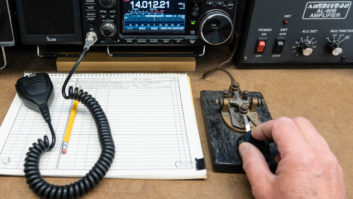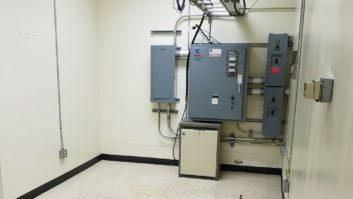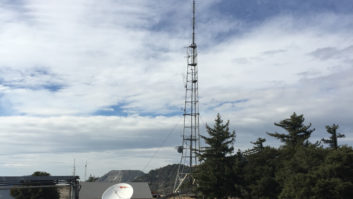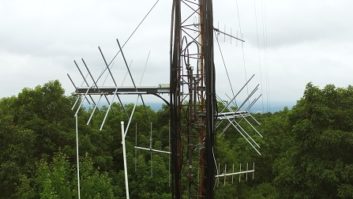This is the second in a series of articles about FM transmission systems. The first appeared Oct. 9.
How many bays do I need in my antenna and how much transmitter power do I need? These questions often do not have hard and fast answers. Rather, the engineer designing an FM transmission system must look at many factors to come up with the best possible combination of antenna gain and transmitter power for a given situation.
For a given value of effective radiated power (ERP) we have a choice of between one and 12 antenna bays. If we are dealing with a Class A or other relatively low-power station, we can narrow the choice down to a fewer number of bays. One would not use a 10-bay antenna, which is more than 100 feet in length, for a 6 kW ERP station. Any savings in transmitter cost would be consumed many times over by the added antenna cost and additional tower height needed to achieve the required height above average terrain (HAAT) with such a large antenna.
On the other end of the spectrum, a 100 kW station would likely not utilize a one- or two-bay antenna. Any savings in tower height and antenna cost would be more than offset by the cost of the large combined-amplifier transmitter necessary to achieve the required ERP with a low-gain antenna.
Economics
With the choices narrowed a bit, we still have a fairly wide range of choices for antenna gain and transmitter power output (TPO) to achieve the required ERP. It is at this point that other factors come into consideration.
Economics probably is the biggest factor with most stations. Without an unlimited budget, a careful analysis of the total cost of each possible TPO/gain combination must be made.
Factors that enter into this equation include the cost of the antenna, transmission line and transmitter, tower cost (keep in mind that larger antennas require taller towers to achieve a given HAAT) and long-term operating cost. Operating cost should be factored in over a period of time, usually the useful life of the transmitter (say, 15 years), and added into the cost equation.
For example, a high-gain antenna/low TPO transmitter combination for a Class B or C station often will result in considerable up-front costs because of added tower height and the cost of a larger antenna, but the power cost savings from the lower-power transmitter will offset this over a period of time. The converse also is true. The best starting point is that range of gain/TPO values that fits the budget.
Once we get past what we can and cannot afford, there are as many answers to what is the “best” gain/TPO combination as there are engineers.
Most any broadcast engineer who has been in the business a while has an opinion on the topic. Most of these are strong opinions, usually based on personal experience in one or more situations. As such, there is a degree of validity to most such views. How, after all, can one argue with empirical data?
The underlying truth, however, is that each situation is unique, with a whole set of variables that may or may not bear any similarity to experiences elsewhere. To get to the right answer for a given situation, one must examine each of these variables.
Terrain
The first of these, and perhaps the one that has the biggest effect on performance, is the lay of the land.
What is the terrain like? The ideal situation is flat, unbroken terrain in all directions from the transmitter site. In that case, the equation becomes one of simple line-of-sight. Unless there is significant population close to the tower site, there is virtually no performance difference between a high-gain/low TPO and a low-gain/high TPO. In such cases, the best combination is the most economical. Find the combination that produces the desired ERP at the desired HAAT for the lowest cost.
Add to the equation terrain features such as hills or mountains and the picture changes. One of the most severe cases is one in which the transmitter site is located atop a high terrain feature with the populated area to be served at significant depression angles below. In that case, the vertical plane radiation pattern of the antenna comes into play. The object is no longer one of producing the maximum amount of signal on the horizon but also (and often more importantly) includes producing good field strengths much closer in.
Manufacturers provide graphs and tabulations of the vertical plane radiation patterns of their antennas. This data can be used to locate the first and second vertical plane nulls as well as the relative field at any angle below the horizon.
With this data in hand, one can use the free-space loss formula along with the ERP to calculate the expected best-case field strength at any given point. The performance of one antenna can be compared to another to find that combination that will best serve the desired areas.
Multiple paths
So far, we have discussed the two extremes, flat terrain and mountaintop transmitter site. Reality is usually somewhere in between. In these cases, where the populated area is far enough away from the transmitter site to be situated well within the main vertical plane lobe of most any antenna, are we back to a simple economic decision? Usually not.
Multipath often exists within the coverage area of an FM station. Multipath is, as its name implies, the result of the signal arriving at the receiving antenna by disparate paths.
There is (usually) the direct, or line-of-sight path, and then there is any number of other paths resulting from reflections and refractions. Instantaneous phase cancellations occur at many points, producing the familiar fuzz and choppiness of multipath. Site selection is the single most important factor in preventing objectionable multipath, but antenna selection has something to do with it as well.
Consider the case in which a transmitting antenna is located just outside of a metropolitan area. The tall buildings downtown are usually pretty good reflectors of RF and their tops tend to be close to the same elevation as the transmitting antenna, thus putting them in the strongest part of the vertical plane pattern. Receivers located in vehicles and homes below are at a disadvantage because they are in a weaker part of the vertical plane pattern and they are in an area where shadowing and attenuation from trees, buildings and terrain features further weakens the direct-path signal.
Now factor in the relatively strong reflected signal from the downtown buildings and you have a recipe for lousy reception in the very heart of the desired coverage area.
One way to combat this is by increasing the amount of direct-path signal by employing a much broader main vertical plane lobe.
This is done by using a lower-gain antenna. The vertical plane main lobe from a lower-gain antenna is much broader, producing stronger signals at lower depression angles, which often will overcome the reflected signals so that complete cancellation does not occur.
I mentioned that every engineer has his own opinion, usually based on some specific experience, as to the “best” TPO/gain combination to produce a given ERP. In my opinion, higher TPO/lower gain combinations produce the most consistent reception. More signal at lower depression angles where the receivers live is almost always a good thing.
As we continue this series, we will look at the options of beam tilt and null fill, both useful tools to help us achieve our objective, which to put the signal where it needs to go.












